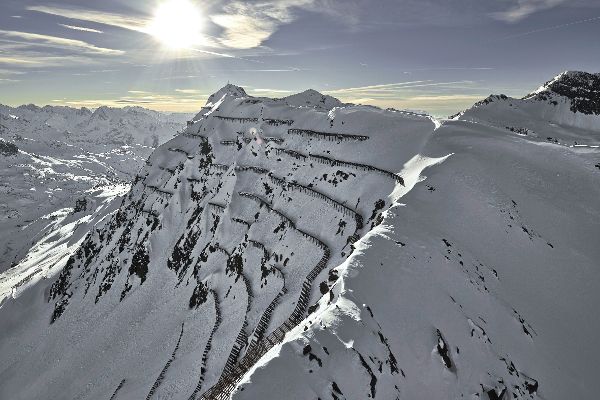Avalanches

Together with other phenomena (snow pressure, snow glide, snow drifts) avalanches represent the complexity of snow processes. Across Austria, there are about 100 avalanche catchment areas. Austria’s torrent and avalanche control takes various measures to protect people and infrastructure against avalanches.
Avalanches
“Avalanches are masses of snow which, when falling from steep slopes, ditches and the like, can cause danger or damage as a consequence of the kinetic energy or the wave of air pressure caused by them or by their deposition.”
This definition under the 1975 Forest Act (section 99(2)) describes avalanches as sliding, flowing or rolling masses of snow or as swirled clouds of snow which are characterised by morphological and kinetic properties.
The catchment area of an avalanche is divided into the starting zone, the avalanche track and the deposition zone.
Depending on the shape of the breaking point, a distinction is made between
- loose snow avalanches, which start from a point and fan outward as they descend and
- slab avalanches, which develop as a result of plates of snow sliding off on a smooth or unstable layer of snow due to the exceeding of the stabilising shear stress and subsequent collapsing.
Depending on the type of movement one distinguishes between
- flowing avalanches (flowing movement of the snow masses) and
- air-borne powder avalanches (a scattering of an air-sow mixture).
Other distinguishing features of avalanches
Depending on whether a slab avalanche starts in the snow cover or on the ground, it is referred to as surface avalanche or as ground avalanche. So while the different starting mechanisms lead to the distinction between loose-snow avalanches and snow slab avalanches, another distinction is made between unconfined avalanches in cases, where snow masses glide extensively, and confined avalanches, where the avalanche comes down in a channel (gully).
Dry snow causes dry-snow avalanches, wet snow causes wet-snow avalanches. A flowing movement of the snow masses will lead to a flowing avalanche; in the case of scattering movement, an air-borne powder avalanche will develop. If the flowing avalanche has a high water content, it may reach down to the ground and pick up its components. In this case it becomes a ground avalanche - a type of avalanche usually experienced in spring.
Avalanches are triggered by heavy new snow fall, rapid rise in temperature, the transport of snow by wind, the steepness of the landscape, and the impact of vegetation. An important phenomenon is the metamorphosis of the snow crystals in the snow cover which depends on the different weather conditions. Apart from self-triggering, also game movements and humans may initiate avalanches (ski tourism, ski mountaineering).
In Austria about 5,800 avalanches are advancing towards the permanent settlement area. Areas particularly prone to the risk of avalanches are located in Vorarlberg, Tyrol, Eastern Tyrol, Salzburg, Upper Carinthia, Upper Styria as well as in the southern part of Upper Austria. Many more avalanches pose a risk to the Alpine ski areas.
Avalanche control
Forest-biological measures
Forests are considered the most efficient protection against avalanches. An uneven-aged, multi-storey and closed stand is the best protection against the development of avalanches below the forest line and the best natural “brake” to stop snow events from areas above the forest line. Forests lift the wind field, have a balancing effect on the snow deposit and prevent the formation of coherent areas of tension in the snow pack, with the latter also becoming very compact in the area surrounding trees.
Technical (engineering) measures
Where the protective effect of forests is poor, avalanche defense works in steel or wood or snow nets are constructed in avalanche-prone areas. In addition, control measures to protect against gliding snow (wooden supports, arrays of posts) reduce snow movement and permit afforestation at the timber line. For the management of protection forests in avalanche catchment areas some specific forest techniques, like the transverse felling of trees, have been developed.
In the run-out zone of avalanches deflecting dams and catchment basins force flowing avalanches to deposit outside the threatened residential area. To protect highways and ski areas also temporarily effective techniques for the artificial (targeted) triggering of avalanches are applied. Among them are avalanche-blasting ropeways, gas exploders or “avalanche organs”.
Permanent avalanche control include also land-use planning measures (Hazard Zone Planning) as well as the information of those concerned or interested in snow- and avalanche-related processes.
- WSL Institute for Snow and Avalanche Research SLF WSL Institute for Snow and Avalanche Research SLF
- Danger level map of the avalanche warning services Austria Danger level map of the avalanche warning services Austria
- SnowSafeApp - avalanche report for Austria, South Tyrol, Bavaria and Slovenia SnowSafeApp - avalanche report for Austria, South Tyrol, Bavaria and Slovenia
- Snow and Avalanche Department of the BFW Snow and Avalanche Department of the BFW